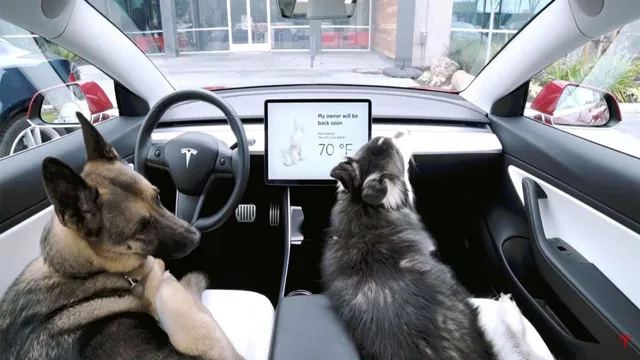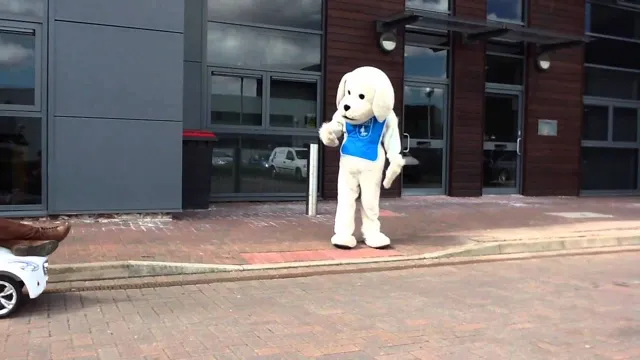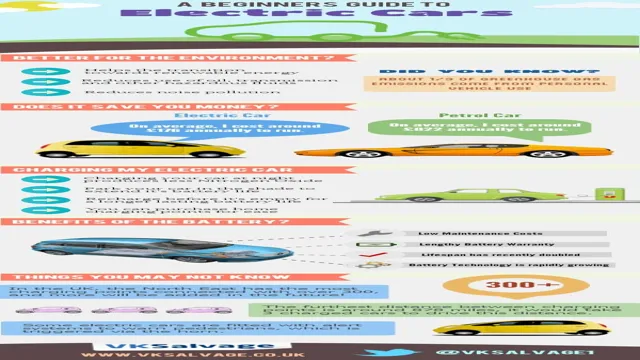Revolutionary Pairing: How Guide Dogs and Electric Cars are Changing the Game
Have you ever thought about how electric cars and guide dogs have something in common? Well, they both play a significant role in improving our lives and paving the way towards a sustainable future. Guide dogs are trained to guide individuals with vision impairments, and electric cars are developed to reduce carbon emissions and improve air quality. But how do these two seemingly unrelated factors connect? Let’s dive in and discover how guide dogs and electric cars are working together to create a better world for everyone.
The Need for Guide Dogs in Urban Areas
Guide dogs play a crucial role in providing independence and mobility to individuals who are visually impaired or blind, especially in urban areas. The advent of electric cars, however, has raised new challenges for both guide dogs and their handlers. Unlike traditional cars powered by internal combustion engines, electric cars emit significantly less noise when they are idling or moving at low speeds.
This creates a scenario where guide dogs cannot detect the presence of electric cars, making it difficult for them to navigate their surroundings safely. As a result, guide dog handlers are required to rely more on their own sensory cues, as well as their dog’s body language, to detect the presence of electric cars. While some electric vehicles are now required to emit artificial noise, the need for ongoing training and education for both guide dogs and their handlers remains essential so that they can continue to work safely in urban environments.
Statistics on Blindness & Visual Impairment
Guide dogs are not just pets, they are essential companions for those experiencing visual impairment. According to the World Health Organization, there are approximately 285 million people globally who have some degree of visual impairment, and of those, 39 million are blind. In urban areas, the need for guide dogs becomes even more crucial as visually impaired individuals encounter obstacles such as traffic and busy crowds on a daily basis.
Guide dogs provide their owners with confidence and independence, allowing them to navigate their surroundings without relying on others for assistance. It’s important for urban areas to consider the needs of visually impaired individuals, including the provision of sidewalks with clear, unobstructed pathways and accessible public transportation. With proper support and resources, guide dogs can help visually impaired individuals live full and fulfilling lives in any environment.

The Role of Guide Dogs in Daily Life
Guide dogs play an instrumental role in the daily lives of individuals with visual impairments, particularly those living in urban areas. These highly trained animals provide their handlers with independence and autonomy as they navigate through busy and congested streets, buildings, and public transportation systems. Urban areas can be especially challenging for people with visual impairments due to the increased risks of accidents, encountering obstructions, and getting lost.
Guide dogs have been specifically trained to overcome these obstacles and lead their handlers safely to their desired destinations. With their keen senses of hearing, smell, and touch, these four-legged companions offer a level of sensory feedback that is invaluable to someone who is visually impaired. The need for guide dogs in urban areas is paramount, as they offer a level of independence and freedom that may not otherwise be possible.
The Challenges with Traditional Cars
One of the challenges with traditional cars is the impact they have on guide dogs. As much as guide dogs are trained to deal with heavy traffic, they often face challenges navigating in an environment filled with noisy and polluting cars. However, with the increasing popularity of electric cars, things are gradually changing.
Electric cars are considerably quieter than traditional cars, which makes it easier for guide dogs to navigate their surroundings and keep their owners safe. While it may take some time for guide dogs to adapt to this new mode of transport, it is an important step towards a safer and more inclusive society for everyone. Therefore, the integration of electric cars with guide dogs represents a milestone in enhancing mobility for visually impaired individuals.
Issues with Noise & Distractions
When it comes to traditional cars, noise and distractions can be major issues that can impact the driver’s experience and safety. The roar of the engine, the sound of tires on the pavement, and the honking of horns can all contribute to a noisy environment that can be overwhelming and distracting. Along with the physical noise, there are also the visual distractions of billboards, other cars, and pedestrians that can take away a driver’s attention from the road.
Furthermore, traditional cars require the driver to shift gears and perform other manual tasks, further increasing the chances of distraction. All of this can make driving a stressful and exhausting experience that can lead to accidents. However, with advancements in technology and the rise of electric cars, these issues can be mitigated.
Electric cars have a significantly quieter engine, which can reduce noise pollution and create a more peaceful environment for the driver and passengers. Additionally, electric cars require less manual labor, allowing the driver to focus on the road and reducing the chances of distraction. Furthermore, the use of advanced technologies such as lane departure warning systems and adaptive cruise control can help keep drivers focused on the road and reduce the risks of accidents caused by distraction.
Overall, while traditional cars have their challenges, advancements in technology are providing solutions to mitigate and reduce the issues of noise and distractions while on the road.
The Importance of Reliable Transportation
Reliable Transportation Getting around from point A to point B has always been an integral aspect of our daily lives. However, traditional cars come with their fair share of challenges. For starters, the cost of fuel, repairs, and maintenance can be quite high.
This can be particularly frustrating, especially when a car suddenly breaks down, and you have no choice but to spend a considerable amount of money to get it fixed. Furthermore, traditional cars tend to emit harmful gases into the environment, contributing to air pollution. This is where reliable transportation comes in handy.
By choosing a reliable mode of transportation, you can avoid the hassle and expense of regular car maintenance and repairs while helping to conserve the environment with eco-friendly options that are both affordable and efficient. Simply put, reliable transportation is a must-have for anyone who values convenience, affordability, and sustainability.
Problems with Gas Emissions & Pollution
Traditional cars have been a staple in our daily lives for decades. However, as times have changed, so have our priorities. One of the biggest problems with traditional cars is the gas emissions they produce, which can lead to pollution and harm our environment.
Not only does this contribute to climate change, but it also affects our health and well-being. In fact, the World Health Organization estimates that air pollution causes seven million premature deaths annually. This is where the shift towards electric cars comes into play – they emit zero emissions, making them a much cleaner and eco-friendlier option.
By making the switch to electric cars, we can help reduce our carbon footprint and preserve the planet for future generations.
The Benefits of Electric Cars for Guide Dogs
Guide dogs and electric cars offer a perfect match for visually impaired individuals. With the quietness and smoothness of electric cars, guide dogs can focus more on their task without the loud and congested environment typical of fuel-powered vehicles. The overall ride quality of electric cars also means the dog’s alertness isn’t compromised, making driving safer for both the dog and its owner.
Aside from the peaceful ride provided by electric cars, they’re also an excellent choice in terms of the environment, contributing to the reduction of air pollution and greenhouse gas emissions. This means guide dogs and their owners can enjoy clean air during walks and other outdoor activities. With more people switching to electric cars, guide dogs and their owners now have an opportunity to experience a cleaner, safer, and quieter city for their daily commute.
Quieter Rides for More Focus
Electric cars have a significant advantage when it comes to guide dogs and their owners. The primary benefit is that they provide a quieter ride, which enables the dogs to focus better on their work. This is particularly important for guide dogs who require their attention to be focused on ensuring their owner’s safety and leading them through busy streets.
Electric cars produce less noise than traditional cars, which reduces the likelihood of the guide dog becoming distracted by noisy vehicles passing by. This means that the guide dog can concentrate on their job and provide greater confidence and mobility for their owner. Switching to electric cars can make a significant difference to the quality of life for guide dogs and their owners.
Improved Air Quality for Canine Health
Electric Cars, Canine Health, Guide Dogs As pet owners, we do everything to keep our furry friends healthy and happy, including ensuring they breathe clean air. Guide dogs, who assist individuals with visual impairments, are no exception. With the rise of electric cars, these canines now have a healthier environment to work in and breathe in.
Electric cars produce zero emissions, which dramatically reduces air pollution when on the road. This cleaner air is particularly beneficial for guide dogs as they spend a significant amount of time outside, walking on sidewalks and crossing streets. The reduction in vehicle emissions has resulted in a decrease in respiratory issues and other health problems among guide dogs.
Additionally, electric cars operate quietly, reducing noise pollution, and allowing guide dogs to focus on their tasks without unnecessary distractions. By choosing to drive an electric car, individuals can directly contribute to improving the air quality and protecting the health of our guide dogs.
The Future of Mobility for Guide Dogs & Their Owners
As electric cars grow in popularity, there is a rising concern for how this new technology will affect guide dogs and their owners. Without the sound of a traditional car engine, it can be difficult for guide dogs to effectively guide their owners across busy roads. However, there are already solutions being developed to address this issue.
One possible solution is the implementation of artificial engine sounds specifically designed for electric vehicles. These sounds mimic traditional car engines, allowing guide dogs to easily recognize the presence of a vehicle nearby. Another solution is the use of smart technology that allows electric cars to “communicate” with guide dogs through their harness, providing important auditory information that can help the dogs better guide their owners.
While these new challenges may be daunting, the future of mobility for guide dogs and their owners is bright with innovation and collaboration between technology developers, service animal organizations, and car manufacturers.
Conclusion
In a world where technology is rapidly advancing, it’s not surprising to see the rise of electric cars. However, let’s not forget the importance of guide dogs in bringing independence and mobility to the visually impaired. While electric cars may be flashy and futuristic, guide dogs are timeless companions that offer not just assistance, but also love and affection.
So when it comes to choosing between these two modes of transportation, let’s remember that sometimes the low-tech option is still the best option.”
FAQs
What is the role of guide dogs in relation to electric cars?
Guide dogs can be trained to navigate around electric cars, helping their blind handlers safely cross roads and navigate through parking lots.
Are there any specific rules or laws for electric cars and guide dogs?
Yes, for example, some states have laws that require electric car manufacturers to install a device that emits sound to alert pedestrians, including those who are blind and rely on guide dogs, of the vehicle’s presence.
Can electric cars pose a danger to guide dogs and their handlers?
Yes, guide dogs may have difficulty detecting the soundless electric cars, which could pose a danger to them and their handlers. It’s important for electric car manufacturers to consider the needs of those with visual impairments when designing their vehicles.
How do electric cars impact the environment and the future of guide dogs?
Electric cars are a more eco-friendly option, which could lead to a better overall environment for guide dogs and their handlers to work in. In the future, advancements in electric car technology may even lead to more efficient and safer transportation for those with disabilities, including those who rely on guide dogs.


